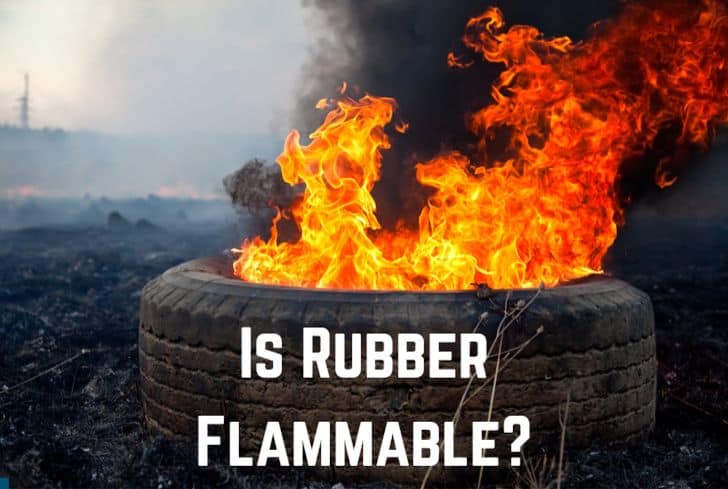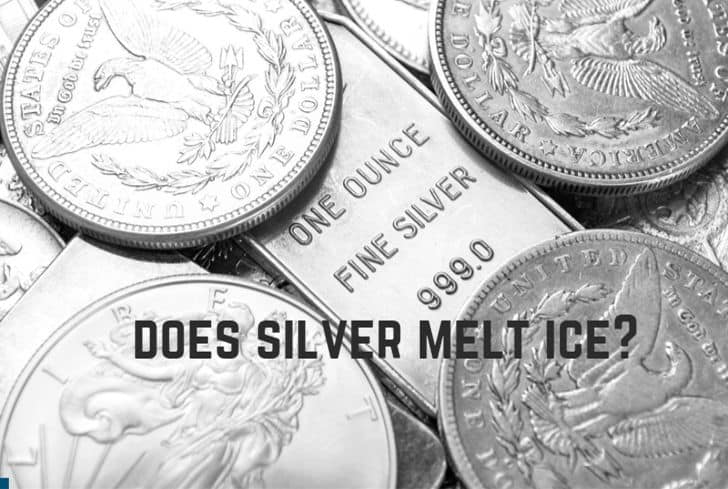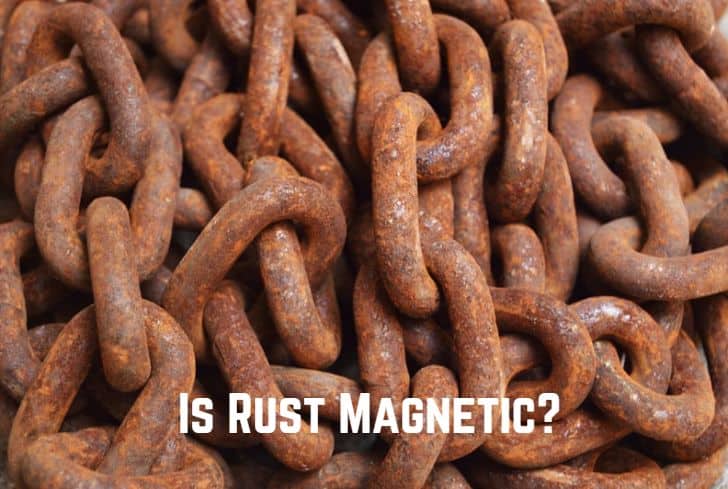Is Magnetite Magnetic? (Answered)
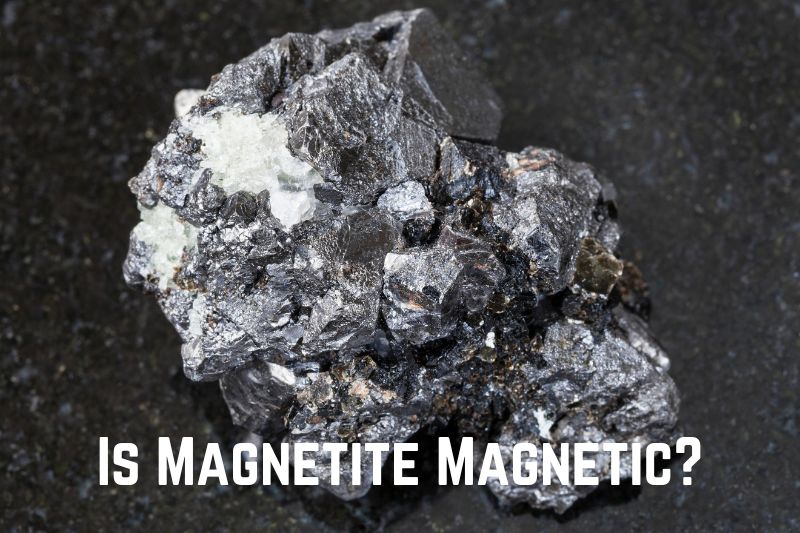
Magnetite is a common earth mineral. Magnetite is composed of three parts iron and four parts oxygen. It is also known as lodestone and has been a priceless mineral since ancient times. Early explorers like Christopher Columbus found it to be quite useful due to one of its properties. Is magnetite magnetic, though?
The first question we will answer in this article is that one. We discuss the formation of magnetite, how it attracts metal or sticks to a magnet, where it is found, and whether it is expensive. Finally, we highlight magnetite’s properties and uses.
Read: Is Palladium Magnetic? (Answered)
Does Magnetite Stick to a Magnet?
A magnetite can stick to a magnet. Magnetite’s (Fe3O4) chemical composition indicates the presence of iron. Iron ions form magnetite’s crystal structure in their ferrous (Fe+2) and ferric (Fe+3) forms. The intricate distribution of electrons in the two iron types gives magnetites their magnetic properties. The oxygen ions organize into a tightly packed cubic lattice inside the magnetic crystals.
A constant flow of electrons between the ferric and ferrous ions, which are always aligned in the same direction, is made possible by the arrangement of iron ions positioned at the interstices (openings). Magnetism happens when electrons point in the same direction.
When exposed to a magnetic field (magnet), the ferromagnetic substance magnetite becomes magnetized. Magnetite retains its magnetic properties long after the removal of a magnetic field.
Magnetite is a mineral that is opaque black and has a metallic sheen. Rubbing it across a hard, rough surface leaves a black streak.
How is Magnetite Formed?
Magnetite often forms as octahedrons (8 sides) or dodecahedrons (12 sides) and crystallizes in an isometric crystal structure. That shows that the crystals’ axis intersects at 90⁰ and are equal in all three dimensions. Magnetite crystals form when magma cools slowly enough for crystals to form and fall out of the magma.
Additionally, it is one of the most common iron oxides. A common accessory mineral found in igneous rock. Microscopic crystals that form magnetite, disperse along the margins of iron minerals. However, it takes more than just a handheld magnet to identify it. But it can be detected by sensitive instruments such as a magnetometer.
Additionally, magnetites form in the following ways:
- Large magnetite ore bodies with powerful magnetic properties can form when mafic magma cools sufficiently slowly to allow dense magnetic crystals to settle.
- When impure, iron-rich limestone undergoes contact metamorphism, magnetite is also produced.
- Additionally, it can develop in high-temperature hydrothermal sulfide vein deposits.
- Magnetite formed as shallow marine deposits during the early proterozoic (2.5 to 1.6 billion years ago) when the world’s atmosphere and seas underwent a profound chemical change.
Where is Magnetite Found?
Magnetite is abundant in Utah, Alaska, Pennsylvania, Missouri, Michigan, Minnesota, and North Carolina. The Ural Mountains, Romania, Norway, and Sweden (Kiruna and Gellivare) are other locations having significant magnetite deposits. The Bushveld complex (Transvaal), the Harz Mountains, Siberia, and the island of Elba is where the most powerful natural magnetite deposits occur.
Since magnetite is an iron oxide mineral, it is present in various geological environments. It exists in igneous rocks, though its small crystals make it rarely visible. The formation of magnetite on the outer edges of iron minerals is the most common. Magnetite can also be found in any of the places provided below.
- It is contained in a rock known as diabase.
- It is present in sedimentary, metamorphic, and igneous rocks as primary or secondary minerals.
- Magnetite can be harvested from silt from lakes, rivers, creeks, mountains, or the sea. Some bacteria can create magnetite upon dying, deposited in sediments such as Magnetofossil.
- Underground, there are high temperatures where quarries, mines, mine dumps, and magnetites form. The typical depth at which magnetite crystals are discovered is 39 feet (12 meters).
- Placer deposit exposures, road cuts, and outcrops can also reveal magnetite.
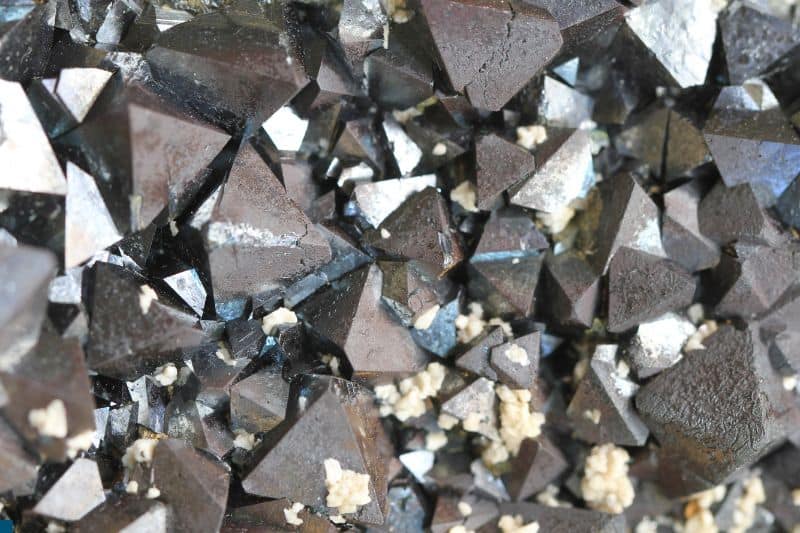
Is Magnetite Expensive?
Magnetite iron ore deposits are highly sought-after due to their increased iron content. The source of steel, which is extremely common in most industries, is iron from magnetite. As a result, one of the most valuable iron ores is magnetite. Magnetite’s real worth comes from all of its potential uses.
Magnetite is currently sold for between $0.5 and $1 per carat. The straightforward table below shows you the various pricing for magnetite using different units.
| Measurement | Price ($) |
| One tonne (1,000 kg) | – 226, 796 to 4,535 925. |
| One pound ( 0.5 kg) | -113 to 2,268. |
| One ounce (28.3 grams) | -7 to 142. |
| One kilogram | -250 to 5,000. |
| One gram | -0.25 to 5. |
| One carat (0.2 grams) | -0.5 to 1. |
The quality, overall appearance, crystal structure, and impurities of magnetite are additional variables that influence price. The cost of mining can also influence the price of magnetite. The price of magnetite will also be subject to demand. For instance, the demand for magnetite rises with high steel demand. Magnetite will cost more money as well.
Does Magnetite Attract Metal?
Magnetite can attract metal. Magnetites naturally get magnetized as a result of lightning. It is made possible by magnetite’s iron content. The iron content of magnetite is 72.4%. Iron’s atomic structure is susceptible to magnetization. Magnetite has a 20 grade for magnetic susceptibility (a material’s tendency to magnetize). Its magnetic properties increase with iron concentration.
Magnetite magnetic properties increase with iron concentration. Lodestone, a naturally magnetized form of magnetite, can act as a magnet. It belongs to the Spinel group. The oxide anions are organized in a cubic configuration in the crystalline structure of the Spinel group. Its cations occupy some or all of the octahedral and tetrahedral regions of the lattice.
The first time man encountered the property of magnetism was when he noticed naturally magnetized pieces of magnetite attracting tiny pieces of iron. Normally, magnetite is attracted to a magnet, but some specimens, known as lodestones, are auto-magnetized and can also attract tiny pieces of iron and other magnetic objects.
The earliest magnetic compasses were lodestone pieces strung on a string in China around 300 BC. A little lodestone will align with the Earth’s magnetic field when it hangs freely.
Properties of Magnetite
Many metal ores are similar to magnetite. It is the only common mineral, nevertheless, to display magnetism. However, graphite, hematite, and ilmenite are sometimes mistaken for magnetite. If there are many other minerals present, magnetism can mask their presence. Additional properties of magnetite are listed below.
Chemical Properties
- Magnetite is a ferroferric oxide.
- It dissolves slowly in hydrochloric acid.
- Magnetite’s chemical formula is Fe2+Fe3+2O4.
Physical Properties
- It has a metallic shine and a built-in magnetic.
- The Mohs hardness range for magnetite is 5.5–6.5.
- When reflected in the sun, it appears black-gray with a brownish tint.
- The sub-conchoidal fracture of magnetite is characterized by its unevenly rounded corners and smooth surface.
- A splitting or break along structural planes could be visible. However, a concentric ripple-like fracture can happen without following natural separation planes.
- Magnetite is a crystal with an isometric crystal form.
Uses of Magnetite
Thessaly, Greece’s Magnesia area, is where magnetite got its name. It is an important site for manufacturing iron and the home of magnets. Due to its unique properties, magnetite is popular in many different applications. We provide a few of its uses.
- Emery is created by combining magnetite with aluminum oxide particles.
- Chert, hematite, and magnetite combine to make taconite, an extremely valuable ore.
- The history of the Earth’s magnetic field is better understood because of magnetite ore. It is possible to determine how the iron in igneous and sedimentary rocks that contain magnetite coordinated with the earth’s magnetic field during formation.
- Magnetite is a key geological indicator to locate metal deposits and look for gold, copper, and iron resources.
- Popular in the manufacturing of steel thanks to its high iron content. The addition of magnetite increases steel’s tensile strength and durability.
- To ensure cleaner water for people, magnetite is also used in water purification systems that rely on magnetite’s magnetic capabilities to attract and remove contaminants.
Read: Is Copper Magnetic? (No…)
Conclusion
Iron oxide in the form of the mineral magnetite is naturally magnetic. As a result, it can stick to a metal and a magnet. Magnetite is common in various geographical environments.
Magnetite prices vary according to demand, quality, crystal structure, physical characteristics, and mining costs.
Frequently Asked Questions
1. How to remove magnetite from metal?
A reducing agent-containing aqueous cleaning solution is used to remove magnetite from metal. The iron III ions are converted to iron II by heating the material to a high cleaning temperature. The pressure vessel is filled with the cleaning solution.
When cleaning conditions are met, an initial substance in the cleaning solution causes the reducing agent to be released.
2. Are all magnetite magnetic?
All magnetites are magnetic. Franklinite and Jacobsite, however, only have a mild magnetic attraction. The most common magnetite type is lodestone, which is naturally magnetic. Its domains naturally line up with the magnetic field of the planet.
The object is either magnetized or inherently magnetic when the domains in a magnet line up.


